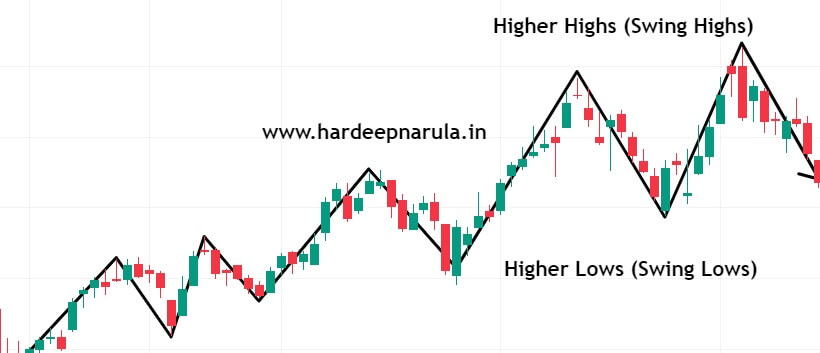When you ask many people who enter the market without learning and suffer huge losses through intraday or option trading, “What are you doing now?”
Their answer would be, “Now I only do long-term investing or swing trading.”
Why? Because losses are minimal in this and the profits are big. It doesn’t mess up the trading psychology.
Even you would find the working professionals and employees telling you the same.
But what exactly is swing trading? Why swing trading?
Let me shed some light on this for you my family.
What is Swing Trading?

A stock never goes up or down in a straight line. Generally, a stock goes into an uptrend or downtrend, or it gets range-bound i.e. in the consolidation phase.
A stock in an upward trend makes ‘higher highs and higher lows’, whereas a stock in a downward trend makes ‘lower highs and lower lows’.
So swing trading is just basically leveraging that price difference and making money out of it.
Bottomline: Swing trading is a trading strategy where traders hold the stock for a few days to several weeks and make profits on the price differences.
One of their ways is to buy it near the swing low (support) and sell it when it comes near the swing high (resistance).
The difference between the low and high is the profits that they take home.
Bonus tip: You can combine swing trading with breakout trading!
Examples of Swing Trading
(1) You purchased 100 shares of XYZ company around the swing low at Rs.200. Sold at 210.
So the price difference i.e. 10 × 100 = Rs.1000 would be your profit.
(2) Amit notices a bank company’s stock bouncing between Rs.50 and Rs.60 over a few weeks. He buys the stock at Rs.50, waits for it to come near Rs.60, then sells it. That’s swing trading.
Amit captured the price difference of Rs.10. So 10 x the no. of shares he had purchased = His PROFITS!!
Why Swing Trading for Beginners and Over Other Trading Types?

(1) Flexibility
It gives you the flexibility to trade along with your job and busy schedule. You don’t need to monitor your trades or the market like day trading constantly.
Positions are held for a few days to weeks.
(2) Less Stressful
The longer holding times allow swing traders to avoid market volatility and noise, leading to less stress compared to intraday trading.
(3) Less Risky
It is less risky compared to intraday or options trading, making it a suitable option for beginners.
As swing trading involves cash/equity transactions (cash trading), it avoids leveraging and overexposure with large quantities.
(4) Especially Suitable for Beginners
As stated above, It is comparatively much less risky which makes it a suitable option for beginners learning how to trade.
It doesn’t require constant monitoring and decision-making, unlike intraday or option trading.
Analysis can be done anytime before taking the trade.
(5) Better Profits and Risk-Reward Ratio
It can make you capture less risky trades with the potential for big profits. It can limit your losses and put the combined rewards of days and weeks in your pockets!
(6) Builds Your Trading Psychology
As you have a higher timeframe/timespan, less noise, less risk, better risk-to-reward ratio, and better flexibility; it helps you to build your trading psychology which is very crucial in trading.
Best Swing Trading Platform
I use “UPSTOX” for all my trades. It has Zero Annual Maintenance Charges.
You can open your FREE trading account if you’re looking out for a trusted and reliable broker.



Hi there, just became aware of your blog through Google, and found that it is
really informative. I am gonna watch out.
I’ll appreciate if you continue this in future.
Many people will be benefited from your writing.
Cheers!